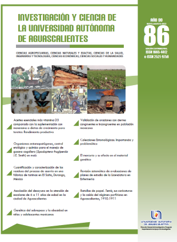Validación de oraciones con cierres congruentes e incongruentes en población mexicana
DOI:
https://doi.org/10.33064/iycuaa2022863534Palabras clave:
probabilidad cloze, componente N400, congruencia semántica, incongruencia semántica, oraciones en español, población mexicanaResumen
El objetivo fue generar y validar oraciones semánticamente congruentes e incongruentes, todas sintácticamente correctas, para población mexicana, y que pueden utilizarse en estudios del efecto del contexto en el procesamiento léxico, en pruebas neurofisiológicas para pacientes con deterioro cognitivo, en el monitoreo de cambios en pacientes con problemas del lenguaje y en la investigación de procesos cognitivos. Homogeneizamos su longitud a cuatro palabras para incrementar el control de variables y presentar la mayor cantidad de ensayos en el menor tiempo posible, disminuyendo la fatiga de los participantes. El resultado es un conjunto de oraciones con varias palabras de cierre, sus respectivos valores de I de Tulving y Gold, probabilidad cloze y ‘nivel de sentido’, de manera que el usuario de estas oraciones pueda elegir entre cierres con diferentes valores. Estas oraciones evocaron el componente electrofisiológico centro-parietal N400 con pico máximo de -4.7 µV y latencia promedio de 401 ms.
Descargas
Citas
• Aborn, M., Rubenstein, H., & Sterling, T. D. (1959). Sources of contextual constraint upon words in sentences. Journal of Experimental Psychology, 57(3), 171-180. doi:10.1037/h0040521
• Arcuri, S. M., Rabe-Hesketh, S., Morris, R. G., & McGuire, P. K. (2001). Regional variation of cloze probabilities for sentence contexts. Behavior Research Methods, Instruments, & Computers, 33(1), 80-90. doi:10.3758/bf03195350
• Bloom, P. A., & Fischler, I. (1980). Completion norms for 329 sentence contexts. Memory & Cognition, 8(6), 631-642. doi:10.3758/bf03213783
• Fischler, I., & Bloom, P. A. (1979). Automatic and attentional processes in the effects of sentence contexts on word recognition. Journal of Verbal Learning and Verbal Behavior, 18(1), 1-20. doi:10.1016/s0022-5371(79)90534-6
• Gironell, A., Crusat, M., Rigau, E., García-Nonell, C., Velo, E., García-Sánchez, C., & Kulisevsky, J. (2003). Validación de la traducción a los idiomas catalán y castellano del potencial evocado cognitivo N400. Neurología, 18(6), 310-317. Recuperado de https://medes.com/publication/9892
• Idiazábal, M. A., Espadaler, J. M., & Vila, J. (2001). Procesamiento semántico en el trastorno por déficit de atención con hiperactividad. Anuario de Psicología, 32(4), 47-64. Recuperado de https://revistes.ub.edu/index.php/Anuario-psicologia/article/view/8794/11030
• Kimble, M., Batterink, L., Marks, E., Ross, C., & Fleming, K. (2012). Negative expectancies in posttraumatic stress disorder: Neurophysiological (N400) and behavioral evidence. Journal of Psychiatric Research, 46(7), 849-855. doi:10.1016/j.jpsychires.2012.03.023
• Kutas, M., & Hillyard, S. A. (1980). Reading senseless sentences: Brain potentials reflect semantic incongruity. Science, 207, 203-205. doi:10.1126/science.7350657
• Kutas, M., & Hillyard, S. A. (1984). Brain potentials during reading reflect word expectancy and semantic association. Nature, 307, 161-163. doi:10.1038/307161a0
• Lepock, J. R., Ahmed, S., Mizrahi, R., Gerritsen, C. J., Maheandiran, M., Bagby, R. M., Korostil, M., & Kiang, M. (2019). N400 event‐related brain potential as an index of real‐world and neurocognitive function in patients at clinical high risk for schizophrenia. Early Intervention in Psychiatry, 15(1), 68-75. doi:10.1111/eip.12911
• Lopez-Calderon, J., & Luck, S. J. (2014). ERPLAB: An open-source toolbox for the analysis of event-related potentials. Frontiers in Human Neuroscience, 8, 1-14. doi:10.3389/fnhum.2014.00213
• Marchand, Y., D’Arcy, R. C., & Connolly, J. F. (2002). Linking neurophysiological and neuropsychological measures for aphasia assessment. Clinical Neurophysiology, 113(11), 1715-1722. doi:10.1016/s1388-2457(02)00224-9
• McDonald, S. A., & Tamariz, M. (2002). Completion norms for 112 Spanish sentences. Behavior Research Methods, Instruments, & Computers, 34(1), 128-137. doi:10.3758/bf03195431
• Olichney, J. M., Morris, S. K., Ochoa, C., Salmon, D. P., Thal, L. J., Kutas, M., Iragui, V. J. (2002). Abnormal verbal event related potentials in mild cognitive impairment and incipient Alzheimer’s disease. Journal of Neurology, Neurosurgery & Psychiatry, 73(4), 377-384. doi:10.1136/jnnp.73.4.377
• Ralph, Y. K., Schneider, J. M., Abel, A. D., & Maguire, M. J. (2020). Using the N400 event-related potential to study word learning from context in children from low- and higher-socioeconomic status homes. Journal of Experimental Child Psychology, 191, 1-15. doi:10.1016/j.jecp.2019.104758
• Rodríguez-Camacho, M., Prieto-Corona, B., Bravo, M., Marosi, E., Bernal, J., & Yáñez, G. (2011). Normas de terminación para la palabra final de oraciones en español para niños mexicanos. Avances en Psicología Latinoamericana, 29(2), 258-275. Descargado de https://www.redalyc.org/articulo.oa?id=79922588007
• Rossi, N. F., Fernandes, C., Moreira, C. S., Giacheti, C. M., Sichieri, B. B., Pinheiro, A. P., & Sampaio, A. (2020). Sentence contexts and cloze probabilities for Brazilian Portuguese children and adolescents. PLOS ONE, 15(7), 1-17. doi:10.1371/journal.pone.0236388
• Schuberth, R. E., & Eimas, P. D. (1977). Effects of context on the classification of words and nonwords. Journal of Experimental Psychology: Human Perception and Performance, 3(1), 27-36. doi:10.1037/0096-1523.3.1.27
• Szewczyk, J. M., & Schriefers, H. (2017). The N400 as an index of lexical preactivation and its implications for prediction in language comprehension. Language, Cognition and Neuroscience, 33(6), 665-686. doi:10.1080/23273798.2017.1401101
• Taylor, W. L. (1953). “Cloze Procedure”: A new tool for measuring readability. Journalism Quarterly, 30(4), 415-433. doi:10.1177/107769905303000401
• Taylor, W. L. (1957). “Cloze” readability scores as indices of individual differences in comprehension and aptitude. Journal of Applied Psychology, 41(1), 19-26. doi:10.1037/h0040591
• Tulving, E., & Gold, C. (1963). Stimulus information and contextual information as determinants of tachistoscopic recognition of words. Journal of Experimental Psychology, 66(4), 319-327. doi:10.1037/h0048802
• West, R. F., & Stanovich, K. E. (1978). Automatic contextual facilitation in readers of three ages. Child Development, 49(3), 717-727. doi:10.2307/1128240
Descargas
Publicado
Cómo citar
Licencia
Derechos de autor 2022 María Guadalupe Yáñez-Ramos, Daniel Zarabozo, Julio Varela

Esta obra está bajo una licencia internacional Creative Commons Atribución-NoComercial-CompartirIgual 4.0.
Las obras publicadas en versión electrónica de la revista están bajo la licencia Creative Commons Atribución-NoComercial-CompartirIgual 4.0 Internacional (CC BY-NC-SA 4.0)









